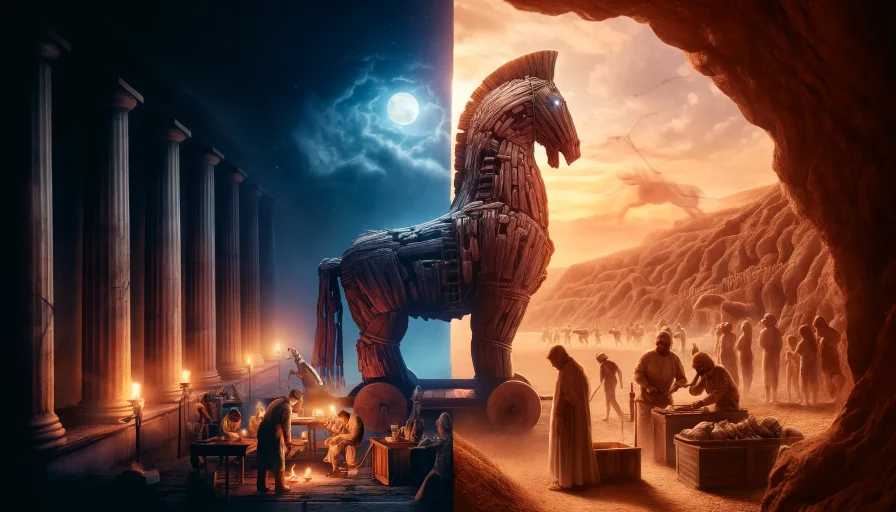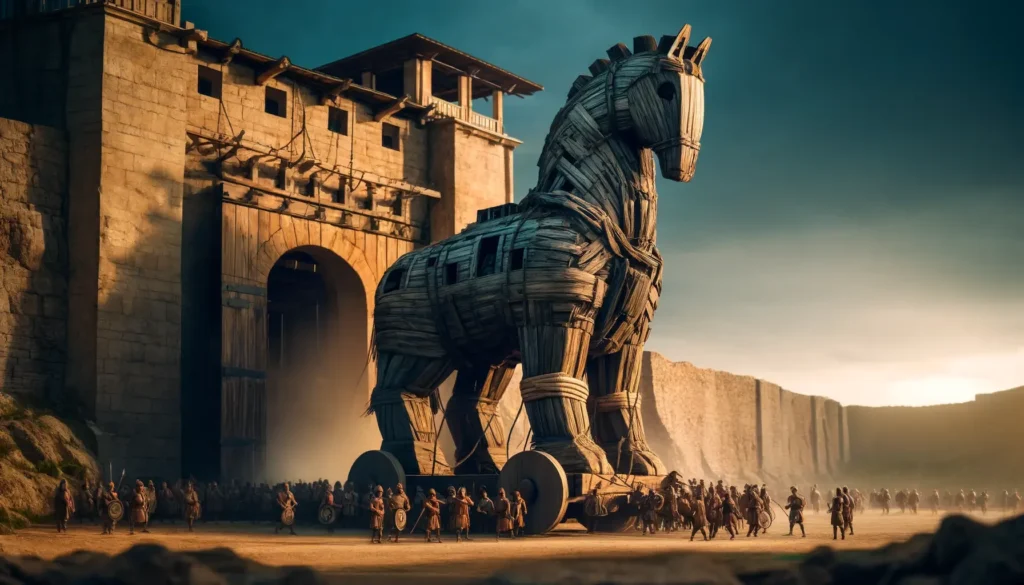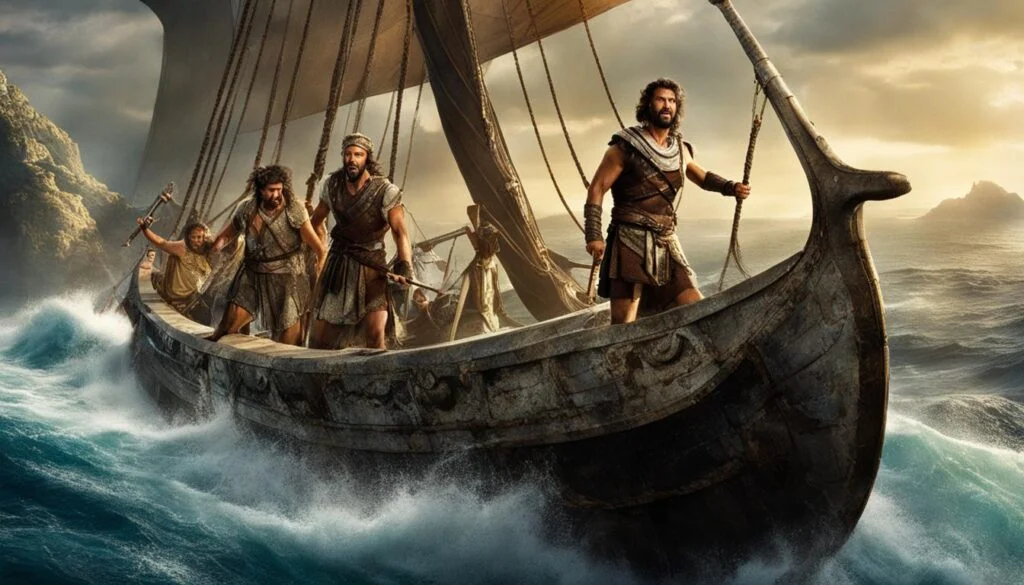Did you know that the story of the Trojan Horse has captured the imagination of people for centuries?
This legendary tale from Greek mythology has become synonymous with cunning deception and clever strategy.
The Trojan Horse is a legendary icon from the ancient Greek epic the “Iliad” by Homer, which describes how Greek soldiers used a giant wooden horse to infiltrate and ultimately conquer the city of Troy. While the story is a famous part of Greek mythology, there is no concrete archaeological evidence to support the existence of the Trojan Horse as a real historical artifact. Most historians and archaeologists consider it a myth or a metaphor for clever military strategy rather than a factual event.
Let’s delve into the reality of this enigmatic event and explore the evidence that supports both sides of the argument.
Key Takeaways:
- The Trojan Horse story is a legendary tale from Greek mythology that describes how Greek soldiers infiltrated the city of Troy during the Trojan War.
- There is ongoing debate among historians and archaeologists about the reality of the Trojan Horse – whether it is an actual event or just a myth.
- The story of the Trojan Horse is primarily known through Homer’s epic poem, the Iliad, but there are variations in the descriptions found in other ancient texts.
- Excavations at the site of Troy and the analysis of ancient military strategies provide historical and archaeological evidence that aligns with the Trojan Horse story.
- The Trojan Horse has taken on symbolic interpretations and continues to have a significant impact on modern culture in various forms.
The Literary Description of the Trojan Horse
The story of the Trojan Horse has captivated readers for centuries, and much of our understanding of this iconic event comes from the literary works of the ancient Greek poet Homer.
In his epic poem, the Iliad, Homer vividly describes the Trojan War and introduces the Trojan Horse as a pivotal element in the story.
Homer’s Iliad has had a profound influence on Western literature and culture. It has sparked countless adaptations, interpretations, and discussions, cementing the Trojan Horse’s place in our collective imagination.
The epic’s rich and detailed portrayal of the Trojan War, including the cunning scheme of the Trojan Horse, has shaped our perception of this ancient conflict.
Homer’s Iliad and the Epic’s Influence
The Iliad is a masterpiece that showcases Homer’s poetic genius and storytelling prowess.
It not only provides a thrilling account of the Trojan War but also delves into the complexities of human nature, honor, and fate.
Through his vivid descriptions and engaging characters, Homer immerses readers in the world of ancient Greece and brings the Trojan Horse to life.
Homer’s influence extends far beyond his own time. His works have inspired and influenced numerous writers, artists, and thinkers throughout history.
The tale of the Trojan Horse, as depicted in the Iliad, continues to resonate with audiences today, testifying to the enduring power of Homer’s literary legacy.
Download a free copy of Homer’s Iliad here.
Variations in Ancient Texts
While Homer’s Iliad is the most well-known literary description of the Trojan Horse, it is important to note that there are variations in the accounts found in other ancient texts.
Different authors and sources present alternative perspectives and details, reflecting the diverse nature of ancient storytelling.
These variations in ancient texts have sparked scholarly debates about the historical accuracy of the Trojan Horse.
Some argue that the variations are a result of oral tradition and different interpretations throughout the ages, while others question the very existence of the event.
Exploring these variations in ancient texts provides valuable insights into the complexities of historical storytelling and the challenges of reconstructing events from the distant past.
Historical and Archaeological Evidence

While the Trojan Horse may be a story rooted in mythology, there is also historical and archaeological evidence that supports the existence of Troy and the events of the Trojan War.
Archaeological Discoveries at Troy
Excavations at the site of Troy in modern-day Turkey have revealed ancient structures and artifacts that align with the descriptions in the ancient texts.
These archaeological discoveries provide tangible evidence of a civilization that existed during the time of the Trojan War.
The remains of defensive walls, towers, and buildings have been unearthed at the archaeological site, providing insight into the layout and construction of the ancient city.
The artifacts discovered, such as pottery, weapons, and jewelry, offer valuable clues about the culture, lifestyle, and warfare of the people who lived in Troy.
These archaeological findings lend credibility to the historical accounts of the Trojan War and suggest that there was a real city of Troy that was besieged and ultimately destroyed.
Analysis of Military Strategies in Ancient Warfare
In addition to archaeological evidence, the analysis of military strategies employed in ancient warfare provides further support for the plausibility of a strategem like the Trojan Horse.
Ancient warfare was characterized by inventive and cunning tactics, with commanders often using deception and surprise to gain an advantage over their enemies.
The Trojan Horse fits into this context as a clever ruse employed to infiltrate the enemy’s defenses and achieve victory.
By studying military tactics from other ancient civilizations and examining historical accounts of battles and sieges, historians and military experts can draw parallels and insights into the feasibility of the Trojan Horse.
The strategies employed in ancient warfare provide a framework for understanding how such a deceptive maneuver could have been executed and its potential effectiveness against Troy.
The combination of archaeological evidence and the analysis of military strategies offers a multidisciplinary approach to understanding the reality of the Trojan Horse and its connection to the events of the Trojan War.
Mythological Symbolism vs. Historical Fact

The story of the Trojan Horse not only holds historical significance but has also become a powerful symbol with various interpretations.
Beyond its role in the Trojan War, the Trojan Horse has been imbued with mythological symbolism that resonates with audiences to this day.
One symbolic interpretation of the Trojan Horse is as a metaphor for deception. Like the Greek soldiers hiding within the wooden structure, the Trojan Horse represents the dangers of deceit and the unexpected consequences that can arise from accepting gifts from enemies.
This symbolism serves as a cautionary tale and a reminder to question the intentions behind seemingly innocent gestures.
In addition, the Trojan Horse serves as a powerful symbol of the dangers of hubris. The Trojan people’s pride and arrogance in their impregnability led to their own downfall when they accepted the hollow gift.
This interpretation highlights the consequences of unchecked arrogance and serves as a warning against overconfidence.
Mythology plays a crucial role in shaping historical events, often serving as a lens through which we interpret and understand the past.
The Trojan Horse story is a perfect example of how mythology can both reflect and influence historical events.
It offers insight into the mindset and strategies employed by ancient civilizations during times of war, showcasing the ingenuity and cunning of the Greek soldiers.
While the Trojan Horse story may have originated as a mythological tale, its symbolic interpretations and contributions to our understanding of historical events cannot be dismissed.
It serves as a reminder of the multifaceted nature of storytelling, where myths and legends often carry deeper meanings and lessons.
By exploring the mythological symbolism and the role of mythology in historical events, we gain a richer understanding of the significance of stories such as the Trojan Horse.
Uncover the secrets behind the real Trojan Horse and delve deeper into the intersection of myth and history.
Gain insight into the historical events that shaped the Trojan War and discover the enduring cultural impact of this legendary tale.
Modern Scholarship and Theories

Over the years, modern scholarship has led to intriguing debates and theories surrounding the Trojan Horse.
Scholars and experts have delved into the historical reality of the event, exploring various perspectives and proposing alternative explanations.
Some argue for its existence as a historical event, while others emphasize its mythological nature.
These scholarly debates contribute to a deeper understanding of the Trojan Horse and its significance in ancient warfare.
Scholarly Debates on the Trojan Horse
The Trojan Horse has captivated the attention of historians, archaeologists, and literary scholars alike.
Theories regarding its purpose, construction, and impact on the outcome of the Trojan War have sparked vibrant discussions within academic circles.
Some scholars argue for the plausibility of a massive wooden horse being used as a strategic tool to infiltrate the city of Troy.
They examine the historical context of ancient warfare and the military tactics of the time to consider the feasibility of such a plan.
Conversely, others propose that the Trojan Horse is purely a literary invention, created to enhance the storytelling and symbolism of the Trojan War epic.
These debates highlight the diverse interpretations and theories surrounding the Trojan Horse, illuminating the complexity of this ancient enigma.
Technological Advancements in Archaeology
Technological advancements in archaeology have brought new perspectives and insights into the exploration of ancient civilizations, including the events surrounding the Trojan War.
Excavations at the site of Troy have uncovered fascinating discoveries that shed light on the reality of the city and its connection to the legendary conflict.
Archaeologists utilize state-of-the-art techniques such as ground-penetrating radar, LiDAR scanning, and DNA analysis to uncover hidden structures, artifacts, and evidence of warfare.
These advancements in technology aid in the reconstruction of the past, allowing researchers to refine their understanding of the Trojan Horse and its place in history.
The British Museum has been at the forefront of these archaeological discoveries, offering valuable insight into the lost city of Troy.
After all, the museum’s extensive collection of artifacts includes noteworthy pieces related to this ancient civilization.
To learn more about the ongoing search for the lost city of Troy, visit the British Museum Blog.
Cultural Impact of the Trojan Horse

Throughout history, the legendary tale of the Trojan Horse has left a lasting cultural impact on modern society.
Its gripping narrative and iconic imagery have permeated various aspects of our culture, from literature and art to film and advertising.
The Trojan Horse in Modern Culture
The story of the Trojan Horse continues to be referenced and adapted in different contexts, showcasing its enduring popularity and resonance.
In literature, authors like Virgil, Dante, and Shakespeare have all incorporated elements of this ancient tale into their works, further solidifying its place in the literary canon.
Artistic representations of the Trojan Horse can be found in numerous paintings and sculptures throughout history.
These visual interpretations capture the intrigue and mystery surrounding this legendary stratagem, inviting viewers to delve deeper into its fascinating narrative.
In the world of film, the Trojan Horse has provided inspiration for epic stories and captivating plot twists.
Movies such as “Troy” and “The Odyssey” have brought the Trojan War to life on the big screen, captivating audiences with their cinematic portrayals.
Even in the realm of advertising, the Trojan Horse has been utilized as a powerful symbol of intrigue and surprise.
Brands and marketers have cleverly employed its imagery to capture attention and create memorable campaigns that play on the theme of hidden surprises, tapping into the cultural familiarity associated with the Trojan Horse.
Educational Use of the Trojan Horse Story
Beyond its cultural impact, the Trojan Horse story serves as an invaluable educational tool. It offers a compelling way to teach lessons about history, mythology, and critical thinking.
By exploring the story’s historical context and significance, students gain insights into the ancient world, the complexities of ancient warfare, and the diplomatic challenges faced by civilizations throughout history.
It encourages critical thinking and analysis, prompting students to question the intentions behind gifts and to consider potential hidden agendas.
Furthermore, the Trojan Horse’s incorporation into educational curricula fosters an appreciation for classical literature and mythology.
It allows students to engage with timeless stories that have shaped our cultural heritage and provides a framework for understanding the impact of mythological narratives on historical events.
The cultural impact of the Trojan Horse is undeniable. It continues to captivate audiences across various mediums while serving as a valuable educational resource.
As we delve deeper into the narrative and explore its influence on modern culture, we gain a greater appreciation for the enduring power of this timeless story.
Conclusion
In conclusion, the question of whether the Trojan Horse truly occurred remains a subject of debate and speculation.
While the story is deeply ingrained in mythology and has become a symbol of deception, its historical basis continues to be examined and analyzed.
The literary, historical, and archaeological evidence, as well as modern scholarship and theories, all contribute to the complex understanding of the reality of the Trojan Horse.
Throughout history, the Trojan Horse has fascinated us with its enigmatic nature. Whether one believes in its historical occurrence or views it solely as a myth, the story captures the imagination and curiosity of people around the world.
It serves as a reminder of the power of storytelling and the lasting impact of ancient myths on our collective consciousness.
As we continue to explore the evidence and analyze new discoveries, the mystery of the Trojan Horse will persist.
The allure of this ancient tale lies not only in its historical implications but also in its timeless themes of strategy, betrayal, and the complexities of war.
Regardless of the conclusion one draws, the enduring legacy of the Trojan Horse will forever captivate and intrigue us.
Frequently Asked Questions
Q: Did the Trojan War actually happen in real life?
The existence of the Trojan War remains a topic of debate among historians and archaeologists. While the war is described in Homer’s epic poems, the “Iliad” and the “Odyssey,” it is considered part myth and part reality. Archaeological evidence suggests that there was indeed a significant conflict in the region where Troy was located, but it is unclear if it was the war depicted by Homer.
Q: Was Helen of Troy a real person?
Helen of Troy’s existence is not confirmed by historical evidence. She is a central character in many Greek myths, particularly the story of the Trojan War. While she is depicted vividly in literature, there is no definitive proof that she was a historical figure.
Q: Did the city of Troy actually exist?
Yes, the city of Troy did exist. Archaeologists have identified the site believed to be ancient Troy in what is now western Turkey. Excavations have revealed several layers of cities built on top of each other, indicating a long history of settlement and conflict.
Q: What evidence is there of the Trojan War?
The primary evidence of the Trojan War comes from archaeological excavations at the site identified as Troy, which show that the city was destroyed and rebuilt multiple times. Additionally, Homer’s epic poems and other ancient texts reference a great war, but these are considered literary sources rather than direct historical evidence.
Q: Who built the Trojan Horse?
According to Greek mythology, the Trojan Horse was built by Epeius, a Greek soldier and craftsman, under the guidance of Athena. It was used as a deceptive tool to gain access to the city of Troy during the Trojan War.
Q: Was Achilles in the Trojan Horse?
No, Achilles was not in the Trojan Horse. Achilles died before the construction of the Trojan Horse, according to Homer’s “Iliad.” The soldiers hidden inside the horse included Odysseus, Neoptolemus (Achilles’ son), and other lesser-known warriors.
Q: What was the Trojan Horse used for?
The Trojan Horse was used as a deceptive ploy by the Greek forces during the Trojan War. It was presented to the Trojans as a peace offering, but it secretly housed Greek soldiers who opened the city gates for the Greek army at night, leading to the fall of Troy.
Q: Where is the Trojan Horse now?
The Trojan Horse, as described in mythology, likely never existed as a real object and thus does not have a physical presence today. It remains a symbol in literature and art, representing cleverness and strategic thinking.




